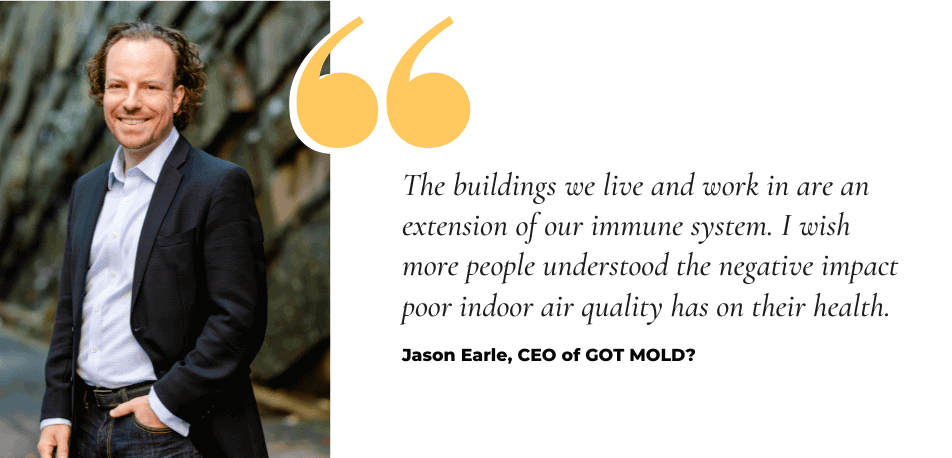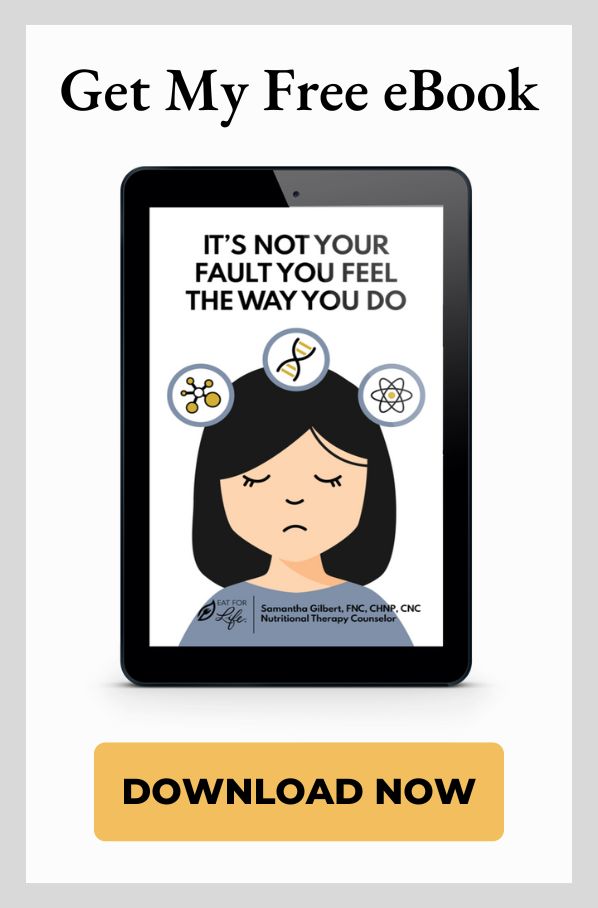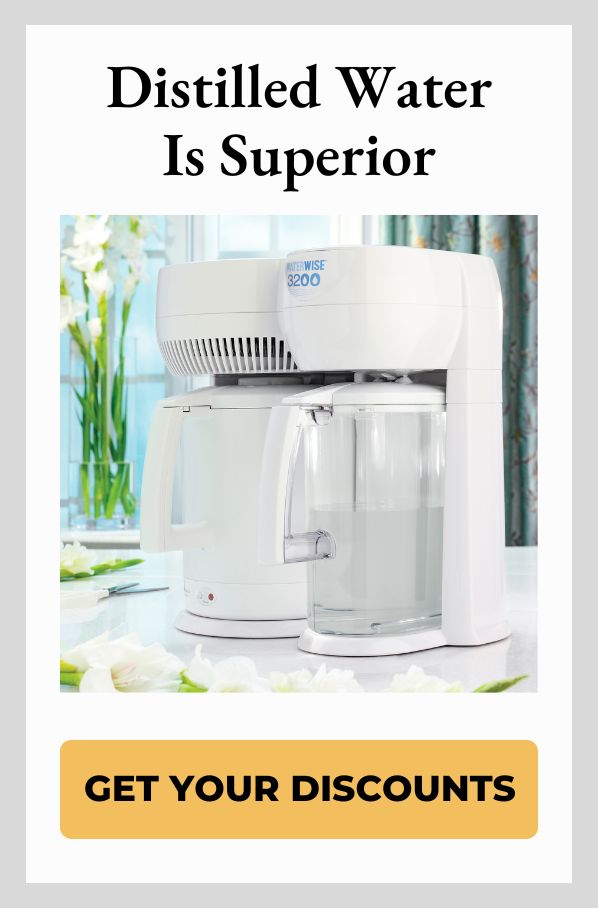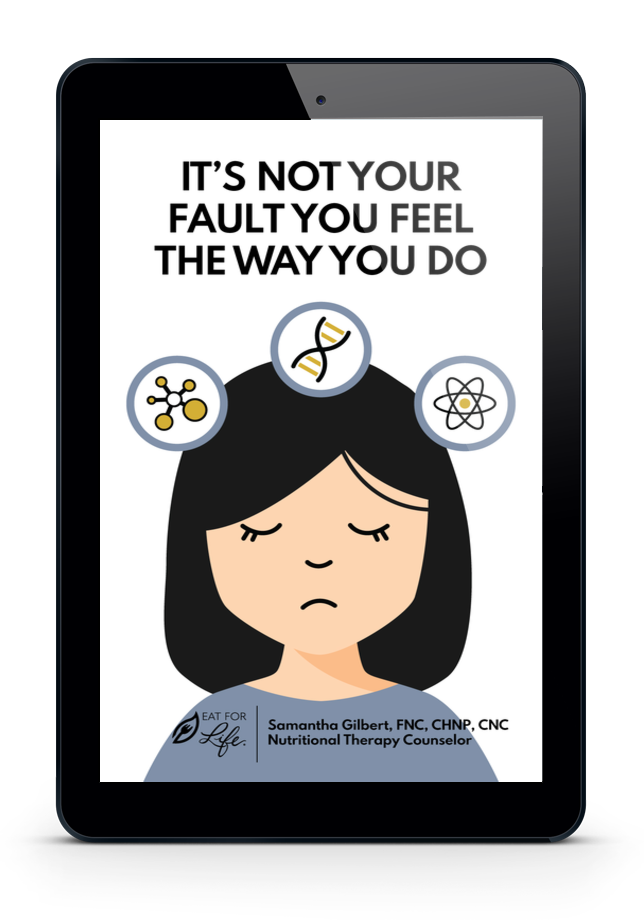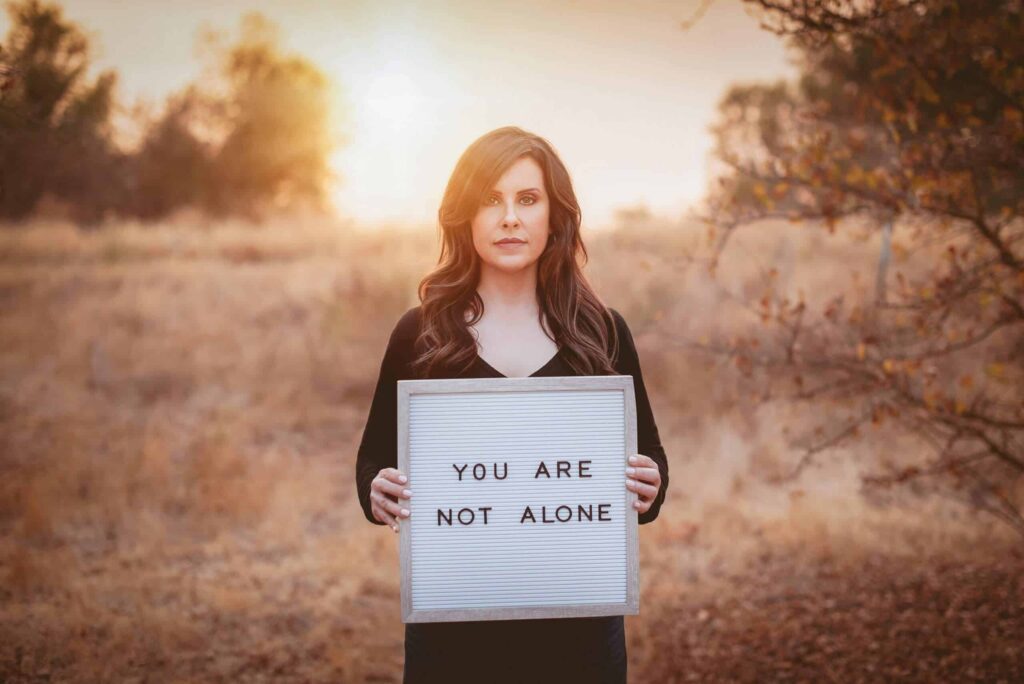We spend at least ninety percent of our time indoors. So the effects of volatile organic compounds, know as VOCs, on indoor air quality and the resultant effect on your health, vitality, cognition, productivity, and longevity are profound.
Hence, understanding how this process works, what to look for, and how you can protect yourself is priceless.
After having watched several of my clients suffer from the consequences of poor indoor air quality has made me appreciate the importance of good air quality even more. In fact, according to the American Lung Association, poor indoor air quality can lead to the development of lung cancer, infections, and even chronic lung diseases such as asthma.
Today I’m joined again by Jason Earle to talk about VOCs, air purifiers, how you can test that your indoor air problem has cleared, and so much more.
In this episode, we discuss:
- What VOCs are, which ones are harmful, and where you can find them
- The effects of VOCs on indoor air quality and the effects on your health
- How you can protect yourself against VOCs
- The importance of indoor microbial diversity for good health
- How to tell if mold remediation has been successful
Listen to the podcast here:
Within the below transcript, the bolded text is Samantha Gilbert and the regular text is Jason Earle.
—
The Effect of VOCs on Indoor Air Quality
Welcome to part two of my conversation with Jason Earle about mold and mycotoxins. As I shared in part one, after watching several of my clients get taken advantage of by so-called mold specialists, I decided to dig deeper into my suspicions about this industry. As a result, I met Jason and he has become my go to expert for all things mold, and understanding how remediation actually works.
Today we talk about VOCs air purifiers and how you can test that the problem has cleared and so much more.
Jason Earle is the founder and CEO of the mold inspection company 1-800-GOT-MOLD and the creator of the Got Mold Test Kit. The realization that his childhood home was the underlying cause of his severe allergies and asthma led him into the healthy home business in 2002, leaving behind a prosperous career on Wall Street. Over the past twenty years, Jason has performed numerous sick-building investigations, solving many medical mysteries along the way, and helping thousands of families restore their health and peace of mind. He has appeared on Extreme Makeover: Home Edition, Good Morning America, the Dr. Oz Show, Entrepreneur, Wired and more.
Thanks for being with us today. Here’s the second half of my conversation with Jason.
So Jason, I want to go back to VOCs. What does VOC stand for? What are the different types of VOCs? And how do they impact the body?
What Are Volatile Organic Compounds (VOCs)?
Well, so VOC stands for volatile organic compounds. And what that essentially means is that these are chemicals that are volatile at certain temperatures. So they go from a liquid state into a gaseous state and potentially back into a liquid state depending upon temperature and the volatility. And a great example of probably the most ubiquitous one is alcohol, which is a liquid at a certain temperature and then it evaporates quickly when you heat it up. Bleach or sodium hypochlorite is also another one where it’s obviously dispensed in bottles, but then at a certain temperature, it will evaporate.
So VOCs are a very important part of our world, many compounds are benign, and even helpful for VOCs. Alcohol is another good example of one right? So it can be used to sanitize a wound and can also be used for intoxication. And like most tools can be used for creation or destruction. And so the thing about VOCs is that when they evaporate, we breed them. Of course, they also produce them. Also in our body and our digestive processes, I mean flatulence is comprised of VOCs. And so you’ve got two different kinds of VOCs, you’ve essentially got manmade, which are the kind that you smell when you walk into a new house, or when you step into your new car. And interestingly, we have associated those chemical smells to success.

Meanwhile, for me, based on that I probably know too much, I smell cancer, because this is poor indoor air quality. If you can smell those smells as sweet as they may be, I can assure you, they’re not good for you. In fact, we won’t even buy a new car at this point because of that concern. And we won’t use paints that have VOCs and thankfully now with building material suppliers now listening to the consumer more, you now have that option. You can buy paints that have toxic VOCs that off gas that contribute to that new house smell or you can buy the ones that don’t smell and so you walk in the house and nothing has changed.
Same thing with finishes on floors. Typical polyurethane is very toxic off gassing, and it takes a long time. New carpet is notorious for this. So these man made VOCs are a real problem in our modern world in large part because we build buildings so tight. And most residential construction does not have air exchange built into the plan. There are no federal regulations or guidelines requiring air exchange and residential buildings. And so we build buildings that are essentially closed up tight for energy efficiency, and for comfort, but contribute to what we call buildup. And that accumulation of off gassing.
By the way, most of this comes from China and is made with quick drying materials like glues and adhesives. And the reason that they dry quickly is because they’ve got these VOCs that volatilize or evaporate at a low temperature. And so quick and cheap means most of the time, a lot of VOCs. And so that’s, you know, your kids toys. I mean, we’re so awash in this stuff. And it has all sorts of metabolic impacts, it has all sorts of immune impacts, again, cancer, I’m not here to scare anybody, but that’s a reality. Yes, it is.
And then you’ve also got the microbial VOCs. And this is an area of deep interest for me. And it’s emerging as an area of significant research in the indoor air quality community. And so just as I said, that we produce gasses during our digestive processes. So to do microbes, in fact, most of the digestive gasses that we produce during our digestion are microbial gasses, you know, mold burps, if you will, or some people refer to them as with a different descriptor, but regardless, they are, you know, effluence, if you will, of microbial digestion. So what happens is a microbe will begin to eat by using enzymes. And in that process, it will destabilize the compound and release, it takes out what it wants, and then releases these chemicals. And these chemicals look a lot like industrial solvents.
What Are the Most Common Sources of VOCs?
So alcohols, ketones, I mean, alcohol is made through microbial fermentation, right? Yeah, so that is a microbial VOC. And so alcohols, ketones, aldehydes, benzene are commonly found coming off of actively growing mold. This is a class one carcinogen, right. And so, again, these are normal compounds in nature, they dissipate when it’s outside, everyone knows what mulch smells like, you know that a lot of times, we notice not the dyes we are smelling, you’re smelling the decomposition of a compost heap. Those are microbial VOCs. When that’s happening in your yard, no problem. That’s what it’s supposed to be doing. And that will be recycled in nature’s gray circle of life, and it’ll be recycled back into other compounds.

But when it’s happening in your house, it accumulates. And what’s emerging in the current research is that the musty smell, which is comprised of a potpourri of microbial gasses, used to be considered an aesthetic nuisance. You know, that’s just the basement smell, right? Yes, that’s just Grandma’s basement. It just smells like that. But the reality is that it is actually a health hazard. And Brown University did a study a long time ago. Now it’s, gosh, 14 years. And they concluded that there was a connection between mold and dampness indoors and depression. I found that fascinating, because my mother was depressed. My mother committed suicide when I was 14 in the moldy house in which I grew up.
And I look back at that now and see that, you know, it was a difficult situation in general, but the mold in the house could not have helped. Absolutely, and in part, probably because she felt disempowered. She also didn’t know anything about mold. Of course, nobody did back then. But the microbial gasses have a role here. And in fact, I had a conversation today with my good friend, Dr. Joan Bennett, at Rutgers, who’s an expert in this area. And she went down to her house right after Hurricane Katrina flooded her place down in New Orleans. She walked in with respiratory protection, and got a faceful of the musty smell, even through the gas mask into the mask, because of course it doesn’t have a HEPA filter and can’t filter out the gasses in the VOCs. And she fell ill.
And she was shocked by this as an expert. She’s a fungal geneticist, as an expert in the area. And she then took that experience and leveraged it into some research where she began isolating the compounds in the musty odor, and exposing them to fruit flies that are genetically engineered to fluoresce when they produce dopamine. And what was interesting was that, when exposed to this one constituent of the musty odor, the fruit flies stopped producing dopamine. They also stopped reproducing, they began flying down instead of towards the light. They developed what she characterized as Parkinsonian like symptoms.
So in other words, they got depressed. Yeah, so this is not a surprise to me, or anyone who’s been in the space for a while, but science is finally catching up. So this goes back to the idea that you know, I mean, listen, anything in moderation, right? But in modern buildings, these things accumulate. And in fact, what’s also interesting is that some studies show that a lot of what we’re breeding indoors, is actually coming from outdoors. There’s a certain degree of infiltration, but what’s really tricky is that the air from outside if it’s polluted, comes inside and stays inside, and you breathe 13 to 15 times a minute, which comes out to about 20,000 times a day, and so you can actually be exposed to outdoor air pollution at a four times higher rate indoors because of the RE breeding.
What Causes VOCs in a House?
And it’s why indoor air is such a huge lever point, right, like good indoor air is nutritive and healing and life giving and unhealthy air is potentially toxic. It will sap you of your vital energy to potentially lead to inflammation and disease. And interestingly, there is no neutral.
You either have good air or bad air, there is no neutral. And so bringing awareness to the subject is my mission, of course. And it’s because it is such a small relative investment. And it’s an area where you can actually exert control, unlike almost anything else out there. You know, we have very little control in this world. But we do have an incredible amount of control over the air we breathe in our own homes, if we’re willing to make the investment, if we’re willing to do the research, if we’re willing to listen to podcasts like this.
And VOCs are a big part of it. If you see it, smell it or feel it, I always say that the smell is a big deal. Your nose is one of the best pieces of test equipment you’ll ever have. And so if you smell that new home smell, if you smell the musty odor, these are not just odors that you’re picking up, you’re breathing that in, and you’re re-breathing that on a consistent basis. And so it’s very important that you do whatever you have to do to minimize exposure to that.
I’m so glad you brought up again, manmade, and then what we see, just as a result of the process of fermentation and break down, again, mold, that’s why we’re doing this show. But when you were speaking Jason, I was remembering, just being at the gym yesterday, and the smell of the weights, the rubber on the weights. And it kind of took me aback a little bit, I didn’t get ill or anything, but it made me think of, okay, I’m in this huge building, I’m surrounded by a lot of plastics, a lot of different man made chemicals and a lot of the equipment that’s being used here. And I can’t help but wonder how this is impacting me, because I do go to the gym quite frequently. And I enjoy being there. And I feel good after I work out. But even when you’re making that effort to take care of yourself and work out, like you said, we’re always exposed, but we do have a choice in terms of our internal air.
So I’m really curious, we’ve touched on this a bit before, but do air purifiers really work? And what are some of the good brands? We did talk about Medify Air, which is the one that I love, and that I have. Can you speak into that a little bit more for us? I know you also said it needs to be a true HEPA with carbon, I believe. Did I get that correct?
VOCs and Air purifiers: Do They Actually Work?
Indeed, indeed. So in terms of what you can do with an air quality problem, I’ll kind of back into this a little bit, there are three things you can do, you can either control the source, so in a case like VOCs, if you’ve got a new finish on your floor, that’s going to be hard, right? If you painted your house, because you didn’t hear this podcast until today, and you painted your house last week, well, that might be a problem, right. And so source control is not always possible or practical. And in cases where that’s not, then you have two other choices. One is dilution, which is essentially ventilation. So bringing in fresh air from a clean source. And that means you have to know that source is clean, right?
It also means that you’re dealing with outside air, which can be hot or cold or humid. And so, it’s really not always practical to do that. And there are specialty equipment called ERVs, and HRVs that are designed to expel stale air and bring in fresh air and transfer the heat or cooling energy, so that you don’t actually just blow your energy out the window, literally. And so, dilution is not ideal, but it’s sometimes a necessary step, especially when you’ve got a large-scale problem. And then the third, which is usually much more approachable, much more affordable, and easier to manage for most people is filtration.
And filtration is simple. You have to force air through a medium that collects or captures the target compound that you’re looking to filter out. And so it’s sort of a hybrid reduction. There’s two kinds of air pollutants. There’s particles and there’s gasses, particles, mold spores, skin cells, paint chips, you know, your building is constantly shedding. The reason through paint is because the paint comes off the wall where you have to refinish your floors, because that finish goes somewhere. Where does it go into the household, dust? And if you’re not removing that stuff, you’re breathing that stuff.
In fact, we can take in dust orally through something called incidental ingestion, which the household does, including those chemically laden dust particles, right? So meaning mechanically removing those particles through HEPA filtered vacuum cleaners, again, True HEPA. So it’s a sealed view, and HEPA filtered air cleaners will help reduce this especially and I think we talked about this too, about kids and pets. They’re the ones who are most susceptible to this. So as opposed to these zappers or these photocatalytic oxidizers, which are not air purifiers, they’re not even air cleaners. You need to have a filter that has a fan, and forces air through a medium that captures the target molecule, so HEPA filters will capture the particles. Then there’s carbon filters, or filters that have activated carbon. And the carbon will capture the VOCs through something called adsorption. So it actually goes around the outside of the carbon molecule almost like magnetically but not magnetically. And so those need to be changed very regularly, otherwise, they become saturated quickly.
So that can get expensive. Also, you want to find a unit that’s got a significant amount of carbon. And I love the Medify units, they probably could use a little bit more carbon to be quite frank. So it’s hard to get everything in one product, unfortunately. And again, I will tell you, as I mentioned before, IQ Air makes a great unit when it comes to marrying those two things. But they’re very expensive. But the Medify units are fabulous. They’re quiet, yes, they are. They’re very, very effective. And I test them with my particle counter. And it seems that nothing gets past them. And they’re also kind of easy on the eyes.
I’m glad you said that. Because I really love mine. And I have one in the bedroom and in the living room, and then one in my office as well. And the living and the kitchen area is kind of an open space area. It’s obviously a large space. But one thing I love, yes, in addition to them being stylish and very sleek, is that they are very quiet. And I’m very particular when I’m sleeping, how I want my sleeping environment to be. I’m very big on sleep hygiene. And I’ve been very, very happy. And also my energy bill, really, there really isn’t a big change in my energy bill, which surprised me. I was concerned about that, to be honest with you. But I was pleasantly surprised that that’s not really the case.
Yes, I’ve noticed that too, that they’re not heavy duty in their usage. And in contrast to some of the other air purifiers that are actually rather cumbersome and loud. You know, but I will tell you that air purifiers have a very, very important place in every single home. I believe they should be operated 24 hours a day, 365 days a year, you don’t turn them off. If anything, when you leave the house, you turn them on full blast, put them in the middle of the room, you want to keep that air moving, but I will say this, your house can be too clean. Never thought about that before your house can be too clean? And so what I always suggest is to filter out as much as you can, because most of the pollutants that you want to filter out unless you live in a city are actually coming from inside the house.
Do Air Purifiers Get Rid of Dust?
The stuff that you want is the stuff that’s coming in from nature. There’s an inverse relationship between microbial diversity and allergies and asthma. They found that the higher diversity you have of microbes in your house, and I’m not saying growing in your house, I’m saying the presence of the spores and the bacterium in your house, the more different kinds you have, the lower the incidence of asthma and allergy. And the numbers are dramatic. I mean, it’s like very, very clear data, but keeping things too clean, throw sanitizers out the window. Don’t use those. Yes, just bad news in every way. You create all sorts of problems, something called competitive release, where you actually allow an environment that’s conducive to only the strongest and nastiest ones.
You don’t want that because that’s how we get resistant organisms like MRSA, and stuff like that. But these exposures that we get from the 50 megatons of spores that the kingdom fungi produces every year, we need those, they’re like little hormetic teaching tools, they teach our immune system, they bounce off of us. And we learn that that’s okay. Take a breath right now, take a deep breath. And exhale in a healthy home, you will have breathed in potentially 1000s of different species. Amazing. In an unhealthy home, you might breathe in maybe 100 or less. That’s the difference. And so you want that microbial diversity, but what you don’t want is an environment that’s conducive to the growth of any of them.
Thanks so much for being part of today’s show. If you’re concerned about mold in your home or workplace, you’re not alone. Moldy environments are a common problem and something I see frequently in my clinical practice. There’s no shortage of mold-testing products available. But sadly, the vast majority are junk science and almost always come up positive for mold, even in normal, healthy environments, something Jason and I talk about extensively in today’s show.
If you’re interested in testing your environment and getting the answers you need, Jason is offering my listeners 10% off your got mold.com Test Kit purchase. I’ve personally used this kit and really like its ease of use, and the data I received was really helpful. Go to GotMold.com and use coupon code EATFORLIFE10. As an added bonus, Jason is offering his step-by-step handbook: “How to Find Mold in Your Home, and Inspect Your Home Like a Pro.” Not everyone needs a professional inspection or can afford one. This easy-to-follow guide will show you where to look, what to look for, and if you find something, what to do next. It’s got inspection checklists, FAQs, and lots of other great resources.
Jason, I’m curious, what about having plants and having them help filter the air as well? And then I don’t want to forget this. You had mentioned this a bit ago. But do you also have any recommendations for a good vacuum? That’s a true HEPA vacuum cleaner?
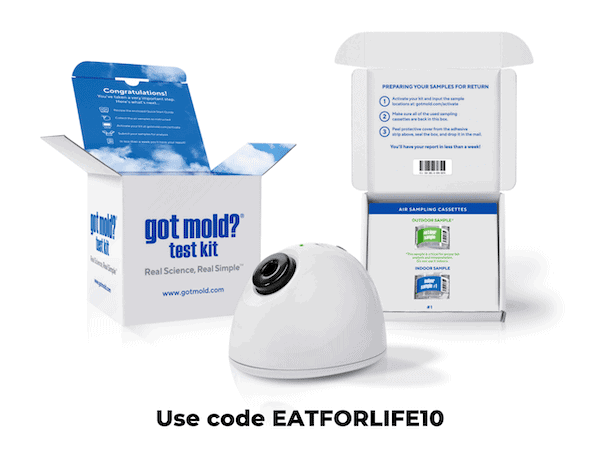
You know, I haven’t looked at that marketplace recently. I liked the Dyson units. I use them, but they have to be emptied outside because they don’t have a bag, right? So if you empty them into the garbage, you will release a plume of very bad stuff. Do that outside and don’t do it with your face in the way. Miele makes great units. But again, they also make units that are not true HEPA. So you can go into a Miele dealership and see great price discrepancies. And what you’ll see is that what makes the difference is the true HEPA versus the natural HEPA.
Thank you for clarifying that.
Yeah, I used to recommend Nilfisk. They’re a European brand. I don’t know if you can get them anymore, but they’re fabulous. And there was one called the Family vacuum. And it kind of looked almost like a toy, but that thing lasted me 15 years.
Which is unheard of these days. Everything is, like you said, made so cheaply. Apartments, homes, cars, you name it. It’s fascinating. And plants do you think? Yes?
Yes, I love plants but don’t overwater them. The plant will let you know, because it’ll die. Plants should be cared for with some benign neglect. You know, in most cases, you shouldn’t have too many of them because they can contribute to a moisture problem that will cause other problems. But yes, I mean, they produce oxygen. And they’re also filtering out on a low level. There’s an article that floated around for a while that NASA was using these in the space station to filter out the air. They were doing experiments. But yes, I’m a huge fan of indoor plants. But like anything, you know, in moderation.
Yes, good point. Thank you for clarifying that. So Jason, I want to go back to remediation. You walked us through beautifully, what it is, what it isn’t. What’s involved, basically. But I forgot to ask you what the end product should be? And how can people test or know that the problem has even been cleared?
How to Know if Remediation Cleared the Mold
Yes, well, so being that this is a very expensive proposition for most people. And oftentimes, people aren’t even able to see the problem when they have it because mold often grows inside walls. And the nature of this is that they’ll close off the space to the homeowner, or to the person contracting the work. And then they’ll do the work behind the plastic. And so you don’t even get to see all that happen. So how do you know when it’s done? How do you know when it’s actually finished? Well, again, going back to remediation, the root word is remedy. Yes, and we’ve already talked about how a mold problem is not the problem. Mold is a symptom of a moisture problem. And so to remedy a mold problem, you must fix the underlying moisture issue.
And so that’s the first step. The first step in all this is to figure out where the water is coming from and stop it. And that’s kind of like half the battle. And it’s not always liquid water, right? Could be humidity, it comes in through various different channels. And sometimes it’s not just one source, which is also tricky. And so you have to make sure that you’ve remedied all moisture problems. And then the idea is that according to the industry standard, which is again, the IICRC S520. They say that the property is remediated when it’s been restored to a normal fungal ecology. Now, if that’s not a little bit of a nerdy phrase. Exactly what is normal?
It’s actually being in quotes, because normal, they can’t define normal, because what’s normal for my house is going to be different than a house in Florida, right? I’m in Minnesota, and what’s normal here in my house is going to be different than the daycare center down the road or the warehouse, you know, the Amazon warehouse down the road. These are different use cases where there’s very different dynamics at play. And so a normal fungal ecology will be different in each place. And so that’s usually done through an assessment using air samples, like the spore traps, and the GOT Mold Test Kit, where you do an outside air sample and you can see what the normal fungal ecology is at that moment in the air.
And then you do the inside air samples in the areas where remediation is being done and also in the surrounding areas to see if there’s contamination there and also to assess what the fungal ecology is in the adjacent area. So you sample outside and then compliant area and the non compliant area. And so that’s considered to be sort of a bare minimum, to be able to get a snapshot or a profile or a cross section of what’s going on in the air.
And so, essentially, what you want to see is that the air has about the same types of molds, and less indoors, okay. And so that defines kind of a normal fungal ecology. The other thing is that you want to make sure that the area in which remediation was done is pristinely clean. And so I go into a project and the first thing I do is a white glove test. And I fail projects all the time, by just walking in and taking my index finger and wiping it across surfaces. If I pick up any dust, that area has not been clean.
When we’re doing remediation, they’re using HEPA filtered vacuum cleaners, and they’re vacuuming up all the stuff wiping everything down and they’re vacuuming, again HEPA, wipe, HEPA. It’s called the HEPA sandwich, the mold remediation mantra, HEPA wipe, HEPA. And you do it over and over and over again until it’s finished. And then you do it three more times. And so the idea is that you’re cleaning while you’re also producing dust, and you’re cleaning up the dust that you produce while you’re cleaning. So you’re kind of cleaning up your own mess as you go along. And kind of chasing your own tail until finally, you get to the point where you’ve cleaned it all and there isn’t any dust left.
And while you’re doing that you’re removing the dust but you’re also removing the spores and the fungal matter. And by the way, everyone was worried about mycotoxins. When we test for mycotoxins we don’t test the air because mycotoxins aren’t airborne, right? Not easily airborne, we test the dust. So if you remove the dust, guess what you’ve also removed mycotoxins. So the idea here is you don’t need to use any special chemicals for mycotoxins or for cleaning, mild detergent if you feel like you need it. But there’s no need for chemicals.
I just have to say, because we’re so used to hearing and being told that we have to have the heavy duty cleaners. And I think I had mentioned, whenever I’m at the gym, I get so annoyed, because they still have the spray bottles, and everyone’s spraying everything. Spraying the equipment and it’s in the air. So I just love hearing you say this, and letting people know, letting our readers know and be at ease, that you don’t have to overdo it with all these harsh chemicals that are actually worse than what you’re trying to accomplish to begin with.
VOCs and Sanitizing Cleaners
They sure are, and some of them are volatile, like we mentioned before, you know, they will evaporate, and what they leave behind, if you kill them all is dead mold, which is still allergenic and potentially toxigenic. The purpose of remediation is to remove it, not to kill it. In fact, oftentimes these things leave behind a residue, which in liquid state, maybe not so harmful, but then they become a dust and the net dust can be inhaled. Some of these are actually hormone modulators and estrogen amplifiers. And so they end up creating a long term health legacy that you don’t want.

And by the way, you can’t remove those chemicals either. So once you’ve done that, even if you clean up all the mold, you still have those chemicals. So you didn’t just trade one toxin for another, you just amplified it. And again, if the water comes back, people love to apply preventative things, paints and coatings and all this stuff, because they don’t want it to grow back. But here’s the good news. If you keep it clean and dry, mold won’t grow. But if you allow it to get wet again, no paint, no coating, there’s nothing that will prevent mold from growing again. It doesn’t matter if people say, “oh, you know, there’s all sorts of inhibitors and stuff like that they all dissipate in time.” Okay, and by the way they dissipate into your home.
Right, I was just thinking of antimicrobial paints, and everything’s antimicrobial. We have it threaded through our textiles. In the beauty care aisle, there are all these activated charcoal infused cleansing sponges and so forth. And I just laugh because it’s marketing, obviously. But what are you really impacting? And same with antimicrobial paints, I assume they’re probably more expensive, right? Because they’re using that as a feature of the paint.
Sure. And at the end of the day, they truly serve no purpose. Yeah, they actually serve a negative outcome. And by the way, I’m going to remind everybody here, this is something really fascinating. Do you know that you have more microbes in your gut than there are stars in our galaxy? Yep. Amazing, isn’t it? Yeah, they used to say it was like 99 to one or 90 to one that we were microbial versus human. And, you know, there’s a great TED talk about this. But the recent numbers that have been thrown around, are more like 36 trillion microbes and 38 trillion human cells, and the people who talk and think about this refer to us as holobionts or superorganisms.
And so we are essentially a host needed for a universe of microbes. And so when we’re playing around with this stuff, these weapons of mass destruction, whether they be antibiotics, or antimicrobials, we are essentially killing ourselves, you know, we are harming our own mutualism, our own symbiotic organisms by doing this. It is so with the best of intentions. But you know what they say about the road to hell, right?
Yes, paved with them. And so just awareness about this. Life needs to live, humans have figured out, most of our ingenuity comes around killing things. We first kill animals with a rock and then with a spear and then with a gun. And then we figured out antibiotics. And then nuclear weapons. Our greatest innovation seemed to be about killing things. And I think the pendulum is swinging, and people are starting to realize that maybe there’s a different way, I hope, as conversations like this, I hope that helped carry that message.
Absolutely. So well said, I appreciate you speaking into that, because I think people are waking up and realizing that we don’t need all these harsh cleaners. They’re impacting our health, like you said, they are endocrine disruptors, they impact neurotransmitter activity, hormones in a significant way, they’ve significantly impacted our children. And in the work that I do with the people that I serve, you mentioned depression and mold earlier, I see that a lot. But it’s also everything else in conjunction, not just the issue with the home. But also, all the chemicals and all the things that we’re exposed to.
And I just hope, I don’t know if this is going to happen in my lifetime. But my hope, and my prayer is that we make some good progress in this area, so that more people become awake and can be healed and understand how these organisms work, how we work with these organisms and our world, and make our world a better place. I know that may sound cliche, but I do believe that that is possible, the more of us that come together in community and understanding and share knowledge, like what you’re doing with us today, and be able to move forward in a really positive and loving way.
As I’ve said, Jason, I’m just so grateful for you. We talked about your early experience and how you got to this place and being an expert in this area. And I truly believe that our greatest weaknesses tend to be our greatest strengths and propel us into areas that we can utilize to help others and to help humanity.
I couldn’t agree more, I often have this notion that no adversity should be wasted.
Beautiful. I so agree with that. Is there anything else you’d like to share with us, Jason?
No, I think we’ve covered a lot of ground here. And I, I’m very excited to have connected here. You know, I always find it very gratifying to connect with fellow philosophers, you know, people who are carrying this torch, and we’re all learning at the same time. We’re all trying to work on this sort of collective learning, yes, and then sharing amongst each other. I love this medium in the podcasts, because we get to do this, you know, at scale.
And I really do think that I maintain a deep optimism about all of this, I believe that you know, the pendulum has swung too far over on the antimicrobial and even the mold fear. I keep having this feeling.
I’ll leave you with this, and I think I mentioned this before, when buildings get sick, we get sick, when the building heals, we heal. And so I will encourage your listeners once again to take a step back and recognize that your home is not just a box that you live in and store your stuff in. It’s an extension of your immune system. And how you treat this building will potentially extend his longevity and also potentially extend your longevity.
Well said thank you so much, Jason, I look forward to having you back on the show in the future.
I look forward to that myself. Thank you.
The negative impact poor indoor air quality has on your health, vitality, cognition, productivity and longevity is profound. Understanding how the process works, what to look out for, and how you can protect yourself, is priceless.
Important Links:
- Eat for Life Ep 61: Top Mold and Mycotoxin Myths Exposed with Jason Earle
- American Lung Association: Indoor Air Pollutants and Health
- Get 10% off your Got Mold test kit using coupon code EATFORLIFE10
- Get $15 off your first Medify Air purifier using coupon code EATFORLIFE15
- 1-800-GOT-MOLD
